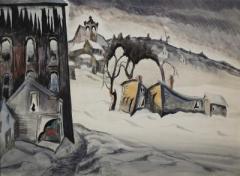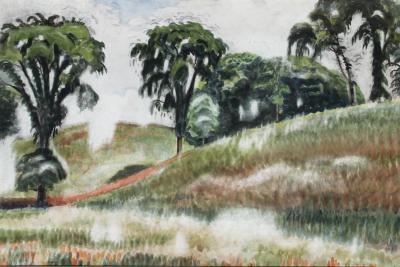Charles E. Burchfield
American, 1893 - 1967
Charles Ephraim Burchfield was born in 1893 in Ashtabula, Ohio and spent the majority of his childhood in Salem, Ohio, where the nearby forests and meadows provided an endless supply of material for his early sketches. He studied at the Cleveland School of Art (now the Cleveland Institute of Art) from 1912 to 1916 and returned to his hometown for the first few years after graduation, working in his preferred medium of watercolor to capture the countryside and seasons he enjoyed from his youth. He was especially drawn to nature’s elements, and to rendering wind, light and atmosphere with the simplest of forms, an idea inspired by the philosophy of Arthur Wesley Dow. While he would always stay true to his Midwestern roots, Burchfield moved to Buffalo, New York in 1921 and took a position as a wallpaper designer for M. H. Birge & Sons Company. In this urban environment, surrounded by the symbols of industry – railroad yards, mills, factories and farmhouses – his own work from this period took on a more realist quality, but were generally infused with a sense of optimism in contrast to the social realism espoused by the Ashcan school artists in New York City. He began showing at Montross Gallery and later with Frank Rehn Galleries in New York, his primary dealer for most of his career, and towards the end of the decade was finally able to quit his job at the wallpaper company to pursue his painting full-time. Museums had also begun to take notice of the artist’s talent. In 1924, the Metropolitan Museum of Art purchased a watercolor, False Front, for their permanent collection and in 1930, a solo exhibition of his work was held at the Museum of Modern Art. Now a husband and father of five, during the mid-1930s Burchfield supplemented his income from his art sales with commissions from Fortune magazine to paint railroad yards in Pennsylvania and coal mines in West Virginia and Texas, and, having become a force in the American art world, he was soon asked to serve on juries for various institutions, including the Carnegie Institute, the Pennsylvania Academy and the Guggenheim Foundation. He was also a regular exhibitor at a number of major art association and museum shows, and was the recipient of many awards and prizes during his lifetime. By 1943, Burchfield’s work had begun to transition again from the realism of his first decades in Buffalo to a revival of his interest in the natural world, and a desire to translate the inscrutable experience of being in the environment. He sought to express not just the visual but also what one hears and senses in a place, resulting in a mystical and very personal body of work lasting from the early 1940s until his passing in 1967. The variables of weather and time of day were of vital importance, with the four seasons serving as his constant muse. Painted in 1954, Summer Haze is his interpretation of the damp heat of a sweltering summer day, with the form of the distant church rippling and the fields of flowers withering under an enveloping humidity. A gifted writer, Burchfield kept a lifetime’s worth of journals recounting the progression of his art and recording thoughts on paintings, the day’s events or general topics that inspired him. One of his entries on summer reads: “’Dog-days’ are here - Stagnant stifling weather hot, humid air, the sun shining brassily from a haze-thickened sky - In the morning heavy dew, with countless silvery webs of the funnel-shaped kind - A cicada or two beginning to be heard at midmorning, grasshoppers putting in the appearance. The season is mounting to the full power and glory of midsummer.” Burchfield taught at the Art Institute of Buffalo from 1949 to 1952, and in 1966 the Charles Burchfield Center at Buffalo State College was opened. Now called the Burchfield Penney Art Center, it holds the largest public collection of the artist’s work, while major examples can also be found at the Art Institute of Chicago, the Museum of Fine Arts, Boston, the National Gallery of Art in Washington, DC, the Butler Institute of American Art in Youngstown, Ohio, and the Fogg Art Museum at Harvard University, among dozens of additional institutions.
Charles Burchfield Paintings & Art
Charles Burchfield Paintings & Art
Charles Burchfield was born in 1893. He studied at the Cleveland School of Art from 1912-16. His work is generally divided into three periods. Up until 1918, Burchfield painted fantasy like woodlands and watercolor landscapes. From 1918 to 1934, he painted the streets of midwestern towns with grimy, rundown houses. This worked gained wide public acceptance. Burchfield experimented with converting sounds of nature into a system of symbolic brushstrokes. Later in his career, this system became an interpretation of his own thought processes and appears frequently in his work. His last works returned to more fantastical themes with enormous butterflies and dragonflies. In 1921, Burchfield moved to Buffalo, NY and worked as the head of the design department of a wallpaper company. He also taught at the Art Institute of Buffalo from 1949-52 and University of Buffalo from 1950-52. The Burchfield-Penny Art Center in Buffalo holds the largest collection of his work and published a comprehensive catalogue of Burchfield's paintings and journals.
Biography courtesy of The Caldwell Gallery, www.antiquesandfineart.com/caldwell
Biography courtesy of The Caldwell Gallery, www.antiquesandfineart.com/caldwell
